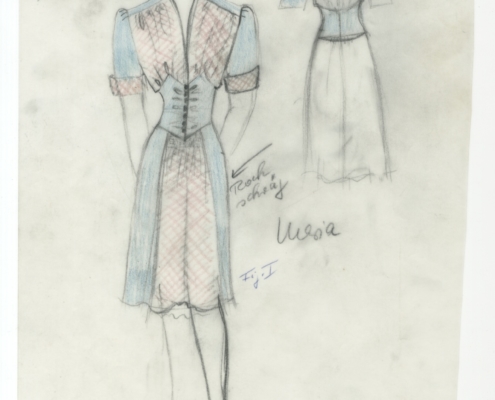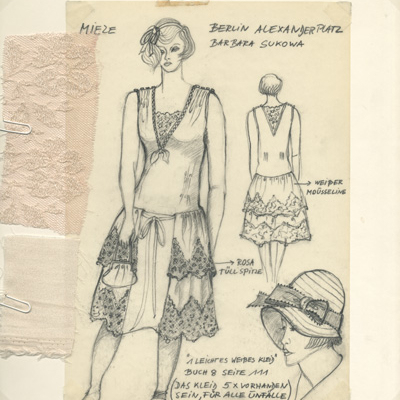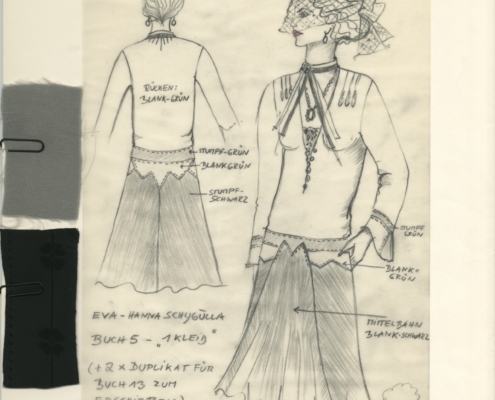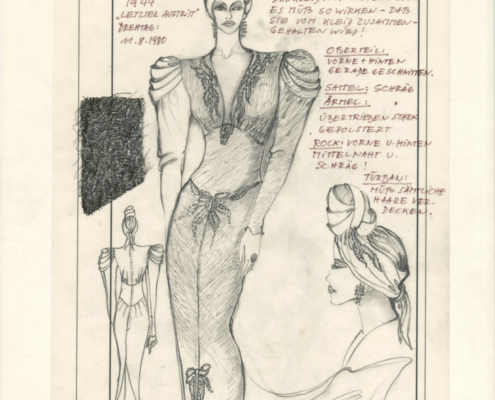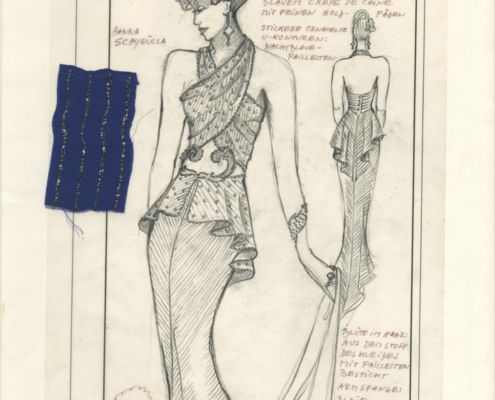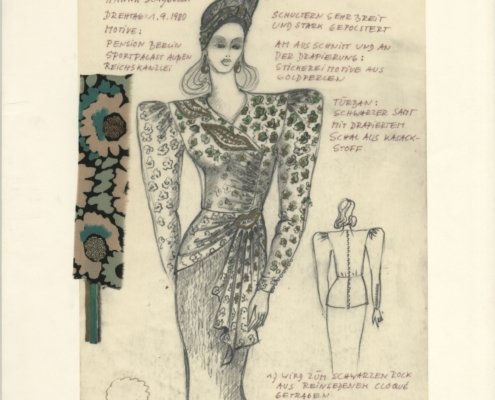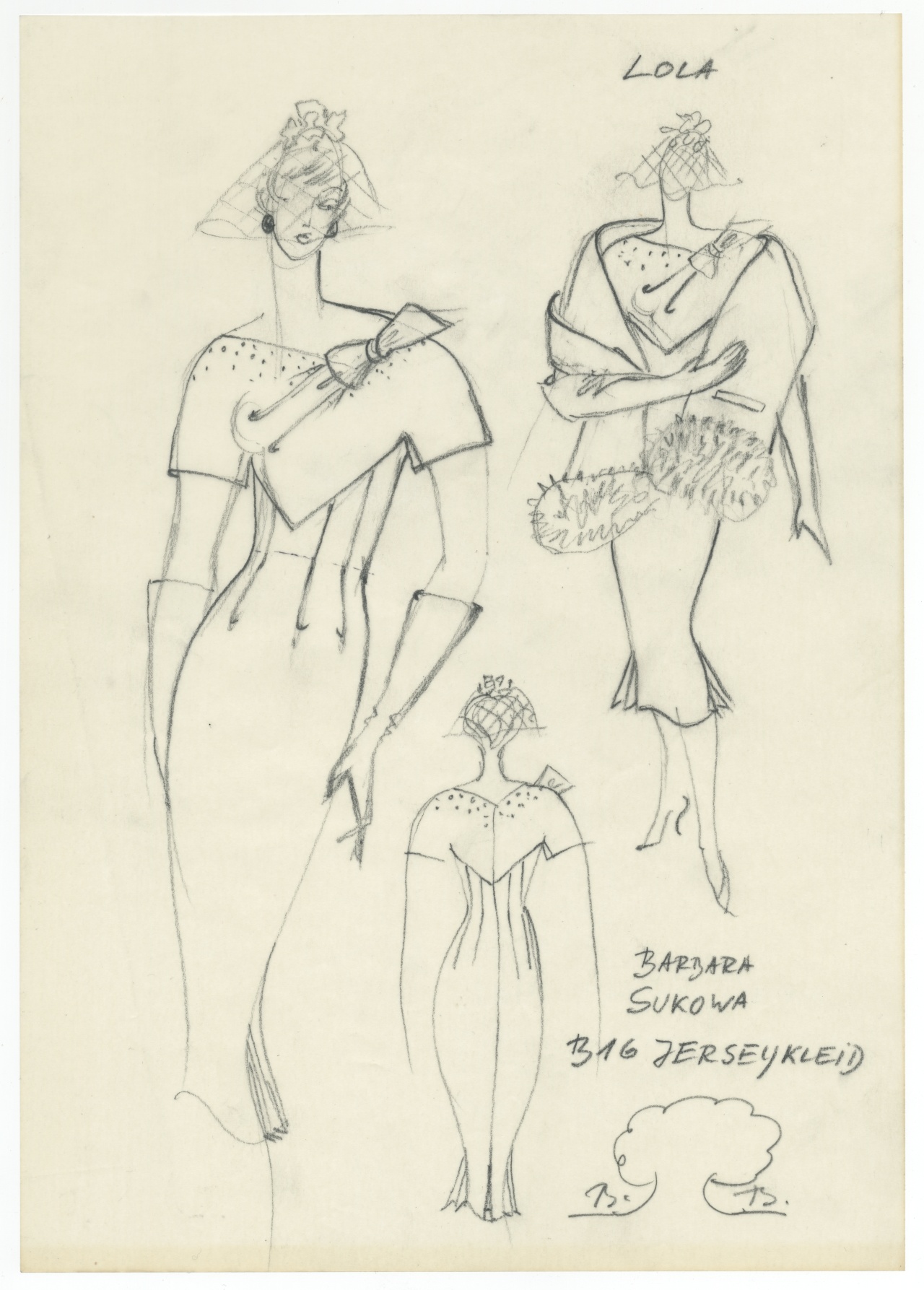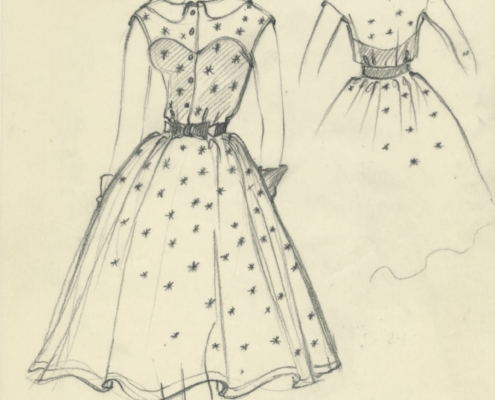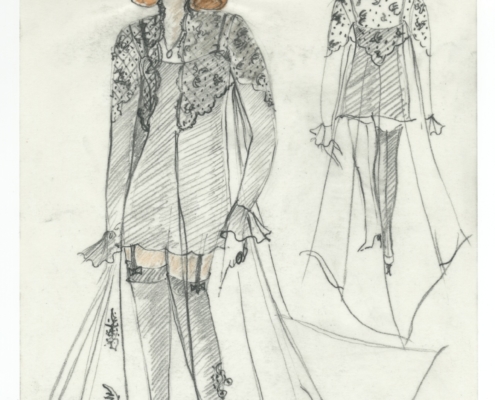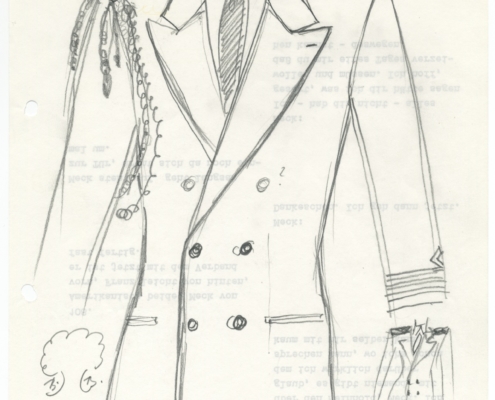“For his first historical movie, Effi Briest, Fassbinder was on the lookout for a professional costume designer. Actress Hanna Schygulla proposed Barbara Baum. At their first meeting, Fassbinder didn’t request any references from Baum; instead he asked her detailed questions about costume ideas. She surprised him by giving very precise answers. Spontaneously, the two of them began discussing the entire screenplay. This was the beginning of an intensive working relationship. Fassbinder had so much faith in Baum’s work that he never asked to see her sketches and designs until shooting began. She worked almost exclusively for him until his death in 1982.“
Barbara Baum on her first collaboration with Rainer Werner Fassbinder on Fontane Effi Briest
1st film: The Marriage of Maria Braun.
Here there are several sketches on tracing paper of costumes for Hanna Schygulla in the title role. One sheet of paper shows a short-sleeved close-fitting dress with a narrow V-neck and a slightly flared skirt. Affixed to the paper are fabric samples – one black, one red check. On another sheet is a sketch for a suit with a flared calf-length skirt and a short black jacket, also flared. A larger sheet below features the design for the blue evening dress with a long-sleeved lace over-blouse. The calf-length, figure-hugging dress has spaghetti straps. Under the knee, the tight skirt features several lace godets – wedge-shaped fabric inserts that cause the skirt to flare. Next to the sketch is the comment: “Flare with and without lace.”
2nd film: Berlin Alexanderplatz.
On the cover of a black notebook Barbara Baum noted that she was working on the costumes for Berlin Alexanderplatz during the shooting of “Maria Braun.” To the right of the notebook is the design for a suit for Günter Lamprecht in the role of Franz Biberkopf. On the tracing paper next to the sketch is a note from Baum: “Make suit three times due to accident. He still has two arms. Plus another one for after the arm is amputated. Book 7, Image 99.” Next to the sketch is a Polaroid showing Günter Lamprecht’s torso. Around his middle is an orthopedic device for concealing his arm. The bottom edge of the display case features two designs for women’s dresses. They show sketches for the role of Eva, played by Hanna Schygulla. The dress has a V-neck and long, flared sleeves. The black skirt is also flared. Two fabric samples are attached to the left-hand side of the sheet. The adjoining sketch shows the dress worn by Barbara Sukowa in her role as Mieze. A tactile graphic for this dress can be found in front of Stage 9, to the left. The graphic on the left is the front view, and on the right the back view, somewhat smaller. A sketch of a straw hat with a broad ribbon can be found in the bottom right corner. The design is a sleeveless, knee-length dress. The straight-cut bodice goes down to the hips, where the lightweight skirt begins. It is fashioned from two flounces with wedge-shaped inserts. Next to that, Baum has noted: “Light pink tulle lace.” The deep V-neckline features an insert of the same lace. A small bow adorns the bottom point of the V-neckline. Two fabric samples are also attached to the left-hand edge of this sheet. On top is the pink tulle lace, underneath a piece of white muslin.
3rd film: Lili Marleen.
On display are three costume designs for Hanna Schygulla in her role as Lili, and a book of notes on the film. The first sketch shows a close-fitting halter-neck evening gown with a short train. A sample of blue fabric is attached to the left-hand edge of the design. Baum noted: “Evening gown of royal-blue crêpe de chine with fine gold threads; embroidered ornamentation and contours: midnight-blue sequins.” To the right of the sketch is Baum’s ring-bound notebook. It lies open and inside is a photograph of Hanna Schygulla wearing this dress in the scene at the Sportpalast in 1942. Underneath the notebook are two more designs. The one on the left has the front view of the silver-lamé evening gown, very large in the center. A tactile graphic for this dress can be found in front of Stage 9, to the right. To the left of the large front view are smaller sketches of the back view; to the right is a representation of the matching headgear in profile. Written above that are a series of notes: “Sportpalast 1944, last appearance, shooting day Aug. 11, 1980. The dress must be figure-hugging. It must look as if she is being held together by the dress. Bodice: straight cut front and back. Yoke: diagonal. Sleeves: excessively padded. Skirt: center seam front and back asymmetric. Turban: must cover all her hair. Embroidery: vines of silver sequins.”
To the right of that design is one for the crêpe de chine casaque with gold lamé dots, along with a fabric sample with a pattern that recalls a sea of daisies. Like in all the subsequent designs in this display case, Baum signed these drawings with her initials “B.B.” to the left and right of a tree, her trademark doodle.
4th film: Lola.
Two designs for Barbara Sukowa in the title role. At the top is a sketch of a knee-length jersey dress. It has short sleeves and a bow on the left shoulder. The close-fitting skirt has side godets. A second view of the front shows the dress worn with a stole. The back view is at the bottom of the sheet, with Baum’s signature next to it.
Below that is a sketch of the organdy summer dress, with the front view on the left, and the back view on the right. On the bottom left is Baum’s signature with notes on the dress to the right of that: “Gossamer summer dress with a petticoat and accompanying corset underdress.” The dress has truncated sleeves and a Peter Pan collar. A belt with a fabric knot at the front marks the place where the wide flared skirt begins. A tactile graphic for this dress can be found in front of Stage 9, in the center.
5th film: Querelle.
On display are three A4 pages of sketches. The first is a design for a negligée for Jeanne Moreau in her role as Lysiane. Pictured is a very short slip with thin straps. On the bottom right of the sheet Baum noted: “Sheer georgette, pure black silk.” Over the slip is a sheer robe with a train. Baum notes: “Bodice: black lace. Skirt: applique lace pattern.”
Another sheet shows the design of the “snake-print dress,” also for Jeanne Moreau. The front view of this close-fitting strapless dress takes up most of the A4 sheet. The décolleté is covered with a transparent fabric that fills the neckline to the throat. Two sketches of the back view complete this design. On the left edge of the sheet is a piece of the dark devoré fabric with a snake-print pattern.
The third sketch shows the naval uniform worn by Franco Nero in his role as Lieutenant Seblon: a double-breasted uniform jacket with epaulettes, and gold braid on the right shoulder.


